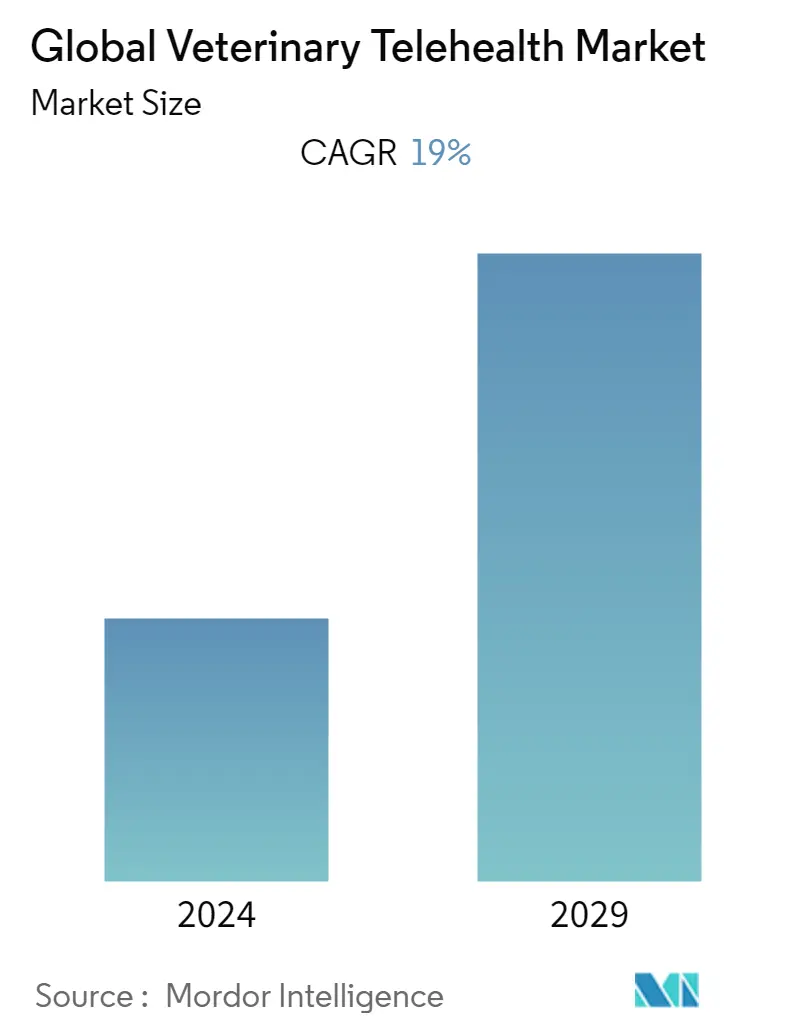Market Size of Global Veterinary Telehealth Industry

| Study Period | 2019 - 2029 |
| Base Year For Estimation | 2023 |
| CAGR | 19.00 % |
| Fastest Growing Market | Asia-Pacific |
| Largest Market | North America |
| Market Concentration | High |
Major Players
*Disclaimer: Major Players sorted in no particular order |
Need a report that reflects how COVID-19 has impacted this market and its growth?
Veterinary Telehealth Market Analysis
The veterinary telehealth market is projected to register a CAGR of 19% during the forecast period (2022-2027).
The COVID-19 pandemic has significantly influenced the veterinary telehealth market. The interest in veterinary telehealth is increasing during the ongoing crisis. Several research showed that use of telemedicine has grown to protect and monitor the health of veterinary patients and veterinary teams. Additionally, the United States Food and Drug Administration (US FDA) was providing flexibility across FDA-regulated industries and announced that it does not intend to enforce certain requirements that may enable veterinarians to better utilize telemedicine to address animal health needs during the pandemic. Moreover, several healthcare organizations have also launched telehealth services. For instance, in March 2021, a leading integrated healthcare company in India, Practo, announced the launch of a veterinary telemedicine service. Thus, the factors mentioned above are leading to an increase in the number of veterinary telehealth services during the ongoing pandemic. Therefore, the pandemic is anticipated to have a significant impact on the market studied.
The growth of the market studied can be largely attributed to increasing pet ownership globally, an increase in pet healthcare spending, and the growing prevalence of zoonotic diseases. These factors are contributing to the increasing adoption of veterinary telehealth services.
Increasing pet ownership worldwide is contributing to the increasing adoption of telehealth services by pet owners. For instance, there has been an increase in pet adoption amid COVID-19, and this increase has occurred across all pet types, especially cats. As per the Canadian Animal Health Institute (CAHI), 2021 survey stats, cats continue to outnumber dogs in Canada, with 8.1 million cats considered to be household pets in the previous year. In addition, Interzoo Exhibition Centre data updated in April 2021 shows that, in total, Germans lived with 34.9 million dogs, cats, small mammals, and pet birds, and this number is almost 1 million more than in the prior years, and as per the source above, 66% of all families with children had a pet, and 13% of all households had at least two types of pets. Thus, increasing pet ownership worldwide is contributing to the rising demand for veterinary telehealth services.
Increasing pet healthcare spending across the globe will boost the demand for veterinary telehealth services. The growing concern of owners for their pets is leading to a huge expense made on veterinary care, such as routine veterinary care, medications, pet treats and food, grooming, insurance, training, pet sitting, and other services, which have surged the adoption of veterinary telehealth services. For instance, the statistics updated by the American Pet Products Association (APPA) show that the United States spent nearly USD 109.6 billion on pets in 2021. Additionally, as per the 'Expenditure Profile 2022-2023' published by the government of India, the Department of Animal Husbandry and Dairying has estimated a budget of USD 39,188 million to invest in the protection and preservation of livestock (Cattle, Sheep, and Poultry) through the provision of health care. Thus, the huge spending on veterinary healthcare indicates an increased usage of veterinary telehealth services.
Moreover, a significant rise in zoonotic diseases such as the prevalence of flea and tick-borne diseases in pet animals has been observed in recent years worldwide. Any pet with access to the outdoors is proved to be exposed to ticks. For instance, Moreover, the research article 'Flea and tick treatment satisfaction, preference, and adherence reported by cat owners in the United States, United Kingdom or France who treated their cats with transdermal fluralaner' published in July 2021, mentioned that a 28.1% prevalence of flea infestation in cats were found in the United Kingdom which is significantly higher than the 14.4% prevalence in dogs. As, telemedicine for pets allows pet parents to reach the veterinarian remotely for examinations, diagnosis, and treatment planning, such an increase in the diseases among companion animals is expected to create demand for veterinary telemedicine, driving the market growth over the forecast period.
However, high costs associated with the services and lack of awareness and accessibility to telehealth services in developing countries are some of the factors hindering the veterinary telehealth market growth.
